前言 这是我听老师讲课做的笔记,考试要看的。 这是视频地址 配套这篇文章解释更香哇!MySQL中SQL数据库基础知识大汇总出炉了 接下来如何创建表结构 添加字段sex,类型为varchar(1) 修改字段sex的类型为tinyint 删除字段sex 删除contacts表 测试: 更新 删除 G格式化输入 用户名和密码对了主机不对也不能连 给用户赋予了mydb所有表权限 如果出现user不是root,host不是localhost的情况root用户就能远程登录 改为只能 本机连 停掉服务 不能关闭窗口 重新开一个窗口 也可以当成计算器使用 为什么会忽略空值,十三个员工平均值不变,会跳过这个员工 按某数值排序,从高到低,从大到小等等 实例: 按照sex性别排序后薪资salary排序 获取记录: 分页: 4.5 数据的分组和筛选 having小于等于五的用法 数据表 多张表,表连接 自连接:有层次结构的表 子查询 in ,exists场景不一样好处不一样 以下用的数据表是上面创建的学生表和数据表 列: 本人博客:https://blog.csdn.net/weixin_46654114 请给我点个赞鼓励我吧
作者:RodmaChen
关注我的csdn博客,更多Linux笔记知识还在更新
本人只在csdn写博客
SQL语言四种结构的练习
一. DDL——数据库、表、视图等的建立、删除
id int not null auto_increment primary key(auto_increment顺序增加)name varchar(30)phone varchar(20)create table contacts( ip int not null auto_increment primary key , name varchar(30) , phone varchar(20) ); 
alter table contacts add sex varchar(1); alter table contacts modify sex tinyint; alter table contacts drop column sex; drop table contacts; 二. DML——添加、删除和修改数据表中的记录

insert into contacts (name, phone) values ("my'love",'108944120'); insert into contacts(name,phone ) value ('啊陈','108944121'); 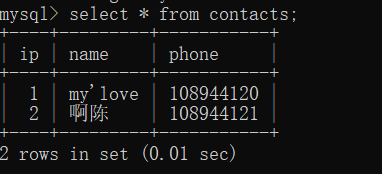
update contacts set phone='110998' update contacts set phone='110998' where name='啊陈'; 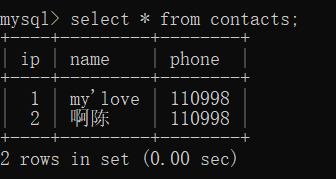
delete from contacts where name='啊陈'; 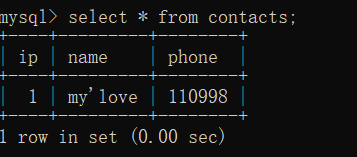
三. DCL——数据库对象的权限管理和事务管理
3.1 用户管理——user
create user 'chen'@'%' identified by '123456'; create user 'yun'@'192.168.0.1' identified by '123456'; 
再打开另一个终端登录用户,观察是否能登录
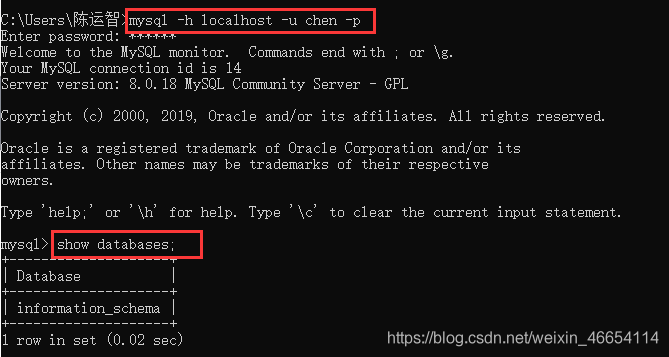

删除mysql> drop user 'chen'@'%'; mysql> drop user 'yun'@'192.168.0.1'; 
修改密码alter user '用户名'@'主机名' identified by '新密码'; 3.2 权限管理
//只有登录的权限 mysql> flush privileges; //给用户赋予了mydb所有表权限 mysql> grant select on mydb.* to 'chen'@'%'; //在查看发现有了select只读权限了 
//删除 mysql> revoke select on mydb.* from 'chen'@'%'; //刷新权限 mysql> flush privileges; 
3.3 禁止root用户远程登录
mysql> use mysql; mysql> select user,host from user; 
%如何机器都能远程登录update user set host='localhost' where user ='chen'; mysql> select user,host from user; 
3.4 忘记用户密码的解决
//停止服务 net stop mysql80 //关闭权限验证 mysqld --defaults-file="C:ProgramDataMySQLMySQL Server 8.0my.ini" --console --skip-grant-tables --shared-memory 

//使用数据表 mysql> use mysql; //查看数据表 mysql> show tables; //user里面包含用户,查看用户 mysql> select user,host from user; 
////刷新权限 flush privileges; //更改root用户密码 alter user 'root'@'localhost' identified by '123456'; 
//重新启动服务 C:WINDOWSsystem32>net start mysql80 //登录进去就行 C:WINDOWSsystem32>mysql -u root -p 
四. DQL——查询数据表中的记录
4.1 select简单查询
mysql> select * from contacts; mysql> select name ,phone from contacts; mysql> select name , phone from contacts where name="my'love"; 

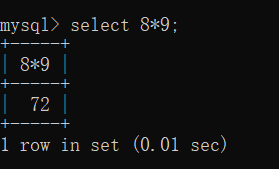
4.2 where条件查询
create table employee( id int not null auto_increment primary key, name varchar(30) comment '姓名', sex varchar(1) comment '性别', salary int comment '薪资(元)' ); insert into employee(name, sex, salary) values('张三', '男', 5500); insert into employee(name, sex, salary) values('李洁', '女', 4500); insert into employee(name, sex, salary) values('李小梅', '女', 4200); insert into employee(name, sex, salary) values('欧阳辉', '男', 7500); insert into employee(name, sex, salary) values('李芳', '女', 8500); insert into employee(name, sex, salary) values('张江', '男', 6800); insert into employee(name, sex, salary) values('李四', '男', 12000); insert into employee(name, sex, salary) values('王五', '男', 3500); insert into employee(name, sex, salary) values('马小龙', '男', 6000); insert into employee(name, sex, salary) values('龙五', '男', 8000); insert into employee(name, sex, salary) values('冯小芳', '女', 10000); insert into employee(name, sex, salary) values('马小花', '女', 4000); select * from employee where sex = '男' and salary >= 10000; select * from employee where sex = '男' or salary >= 10000; select * from employee where sex = '男' and salary <= 4000 or salary >=10000; 
4.2.1 in的用法
select * from employee where id=1 or id =2 or id =3; select * from employee where id in(1,2,3,4); 
4.2.2 like用法
select * from employee where name like '张三'; select * from employee where name like '李%'; 
4.3 函数
mysql> select now(); 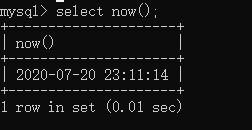
4.3.1 聚合函数
mysql> select count(*) from employee; mysql> select count(*) from employee where sex ='男'; mysql> select count(*) from employee where sex ='女'; mysql> select sum(salary) from employee; mysql> select avg(salary) from employee; mysql> select max(salary) from employee; mysql> select min(salary) from employee; 

4.3.2 case when判断条件语句
select id, name, case sex when '男' then 'A' when '女' then 'M' else '' end as sex, salary from employee; 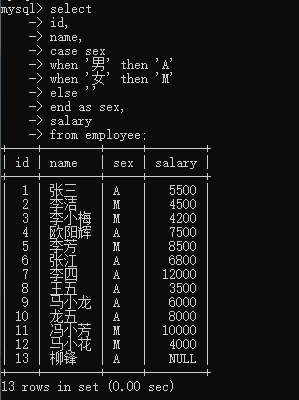
4.4 查询结果排序与分页
4.4.1 order by 排序
薪资排序:salary,降序后面加descmysql> select * from employee order by salary; 
select * from employee order by sex ,salary desc; 
4.4.2 limit 分页查询
mysql> select * from employee limit 2; 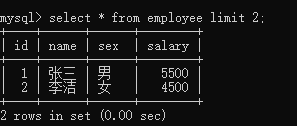
mysql> select * from employee limit 3,3 ; 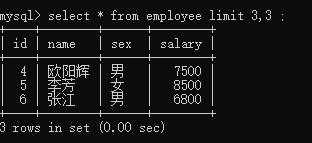
4.5.1 group by——分组4.5 数据的分组和筛选
4.5.1 group by——分组
select sex ,count(*) from employee group by sex; select sex ,sum(salary) from employee group by sex; 
4.5.2 having——筛选各组数据
mysql> select sex , count(*) from employee group by sex having count(*)<=5; 
4.5.3 group_concat——显示统计数量列表
mysql> select sex ,count(*) ,group_concat(name) from employee group by sex; 
select sex,count(*) , group_concat(name order by name desc) from employee group by sex; select sex, count(*),group_concat(name order by name desc separator ';') from employee group by sex; 
4.6 去除重复数据——distinct
create table footprint( id int not null auto_increment primary key, username varchar(30) comment '用户名', city varchar(30) comment '城市', visit_date varchar(10) comment '到访日期' ); insert into footprint(username, city, visit_date) values('liufeng', '贵阳', '2019-12-05'); insert into footprint(username, city, visit_date) values('liufeng', '贵阳', '2020-01-15'); insert into footprint(username, city, visit_date) values('liufeng', '北京', '2018-10-10'); insert into footprint(username, city, visit_date) values('zhangsan', '上海', '2020-01-01'); insert into footprint(username, city, visit_date) values('zhangsan', '上海', '2020-02-02'); insert into footprint(username, city, visit_date) values('lisi', '拉萨', '2016-12-20'); //看用户distinct mysql> select distinct username from footprint; //group by也可以去重,不过它做的是分组统计的,distinct只做去重 mysql> select username from footprint group by username; //每一个用户去过的城市 mysql> select distinct username ,city from footprint; 
4.7 表连接(内连接、外连接、自连接)
主要学习内连接和左连接drop table if exists score;//数据表 drop table if exists student;//学生表 create table student( stu_no varchar(20) not null primary key comment '学号', name varchar(30) comment '姓名', address varchar(150) comment '地址' ); insert into student(stu_no, name, address) values('2016001', '张三', '贵州贵阳'); insert into student(stu_no, name, address) values('2016002', '李芳', '陕西兴平'); insert into student(stu_no, name, address) values('2016003', '张晓燕', '江西南昌'); create table score( id int not null auto_increment primary key, course varchar(50) comment '科目', stu_no varchar(20) comment '学号', score int comment '分数', foreign key(stu_no) references student(stu_no) ); insert into score(course, stu_no, score) values('计算机', '2016001', 99); insert into score(course, stu_no, score) values('离散数学', '2016001', 85); insert into score(course, stu_no, score) values('计算机', '2016002', 78); 4.7.1 内连接
//内连接 join select A.stu_no, A.name ,B.course,B.score from student A join score B on(A.stu_no=B.stu_no); // inner join select A.stu_no, A.name ,B.course,B.score from student A inner join score B on(A.stu_no=B.stu_no); // where select A.stu_no, A.name ,B.course,B.score from student A ,score B where A.stu_no=B.stu_no; 
4.7.2 左连接
//左连接 select A.stu_no, A.name ,B.course,B.score from student A left join score B on(A.stu_no=B.stu_no); // 交叉连接:没有按照学号进行关联(没啥用) select A.stu_no, A.name ,B.course,B.score from student A ,score B; 
4.7.3 自连接
drop table if exists area; drop table if exists area; create table area( id int not null auto_increment primary key comment '区域id', pid int not null comment '父id(0-省份)', name varchar(30) comment '区域名称' ); insert into area(id, pid, name) values(1, 0, '贵州省'); insert into area(id, pid, name) values(2, 1, '贵阳'); insert into area(id, pid, name) values(3, 1, '遵义'); insert into area(id, pid, name) values(4, 0, '广东省'); insert into area(id, pid, name) values(5, 4, '广州'); insert into area(id, pid, name) values(6, 4, '深圳'); // 父类不等于0的子类 mysql> select * from area where pid<>0; // 父类和子类的连接 mysql> select A.id , A.name, B.name as provinceName -> from area A,area B -> where A.pid=B.id and A.pid<>0; 
4.8 子查询EXISTS和IN的使用

查询所有选修课程的学生 select A.* from student A where A.stu_no in(select B.stu_no from score B); 查询选修了离散数学的学生 select A.* from student A where A.stu_no in(select B.stu_no from score B where B.course='离散数学'); 查询所有选修了课程的学生 select A.* from student A where exists (select * from score B where A.stu_no =B.stu_no); 查询所有未选修课程的学生 select A.* from student A where not exists (select * from score B where A.stu_no=B.stu_no); 
小知识
mysql> show variables like '%datadir%'; 
//select abs(-10);绝对值 select abs(-10); //求字符串长度 select length("cheng"); select length("cheng") from dual; select * from dual; 

本人b站求关注:https://space.bilibili.com/391105864
转载说明:跟我说明,务必注明来源,附带本人博客连接。

本网页所有视频内容由 imoviebox边看边下-网页视频下载, iurlBox网页地址收藏管理器 下载并得到。
ImovieBox网页视频下载器 下载地址: ImovieBox网页视频下载器-最新版本下载
本文章由: imapbox邮箱云存储,邮箱网盘,ImageBox 图片批量下载器,网页图片批量下载专家,网页图片批量下载器,获取到文章图片,imoviebox网页视频批量下载器,下载视频内容,为您提供.
阅读和此文章类似的: 全球云计算
 官方软件产品操作指南 (170)
官方软件产品操作指南 (170)